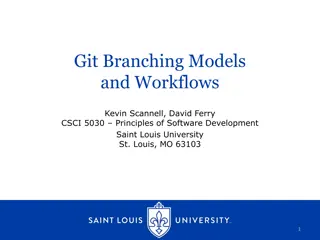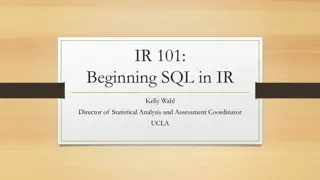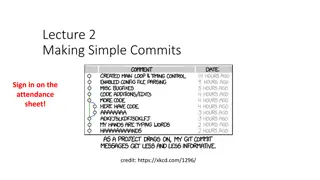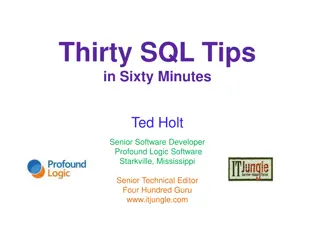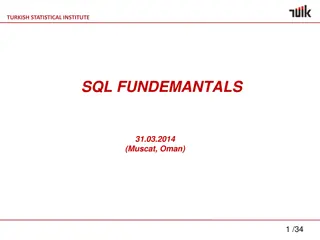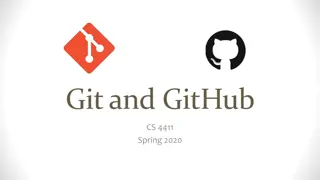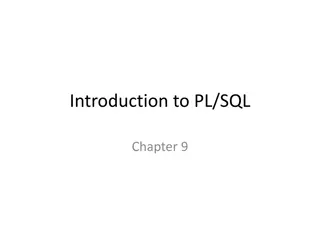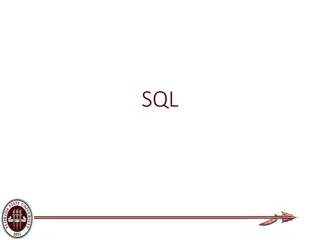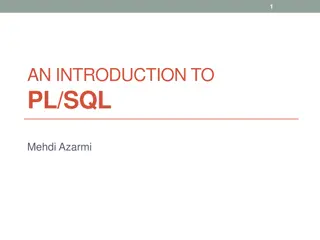
PostgreSQL Command Line Interface Overview
Explore the PostgreSQL command line interface for interacting with databases, executing SQL statements, managing tables, creating users, and utilizing helpful commands. Learn about psql commands, PostgreSQL GUI tools, branching with Git, database management tips, and SQL sequence resetting techniques.
Uploaded on | 1 Views
Download Presentation

Please find below an Image/Link to download the presentation.
The content on the website is provided AS IS for your information and personal use only. It may not be sold, licensed, or shared on other websites without obtaining consent from the author. If you encounter any issues during the download, it is possible that the publisher has removed the file from their server.
You are allowed to download the files provided on this website for personal or commercial use, subject to the condition that they are used lawfully. All files are the property of their respective owners.
The content on the website is provided AS IS for your information and personal use only. It may not be sold, licensed, or shared on other websites without obtaining consent from the author.
E N D
Presentation Transcript
psql Command line interface for postgresql Commands start with \ SQL statements end with ; Handy commands: psql U username //to login \dt //list all tables \q //quit \i filename.sql //execute a file with sql instructions SELECT * FROM myTable; //Just what it says!
PostgreSQL GUI for Postgres Useful for some things like initial DB creation or creating users You should see the SQL server here
Expanding the server will show the database(s)
Tables are way down here (or use psql)
Running a single unittest python -m unittest tests.test_generic.TestChat.test_loading path Module name Class name Method name
git and branching You can create branches either from the gitlab GUI, or command line (doesn t matter) I like using command line e.g. > git checkout b new-branch > git push u origin new-branch Or switching branches >git branch db-utils *main > git checkout db-utils
git and branching You can create merge requests from the GUI or command line I actually prefer doing it from the GUI
Gitlab GUI for commenting
Other points If you have a PK defined SERIAL PRIMARY KEY If you do manual INSERTS and specify the PRIMARY KEY (INSERT INTO my_table (id,data ) VALUES (1, something ) then The DB no longer knows which PK to use next (since you bypassed it) To RESET that sequence use: ALTER SEQUENCE my_table_id_seq RESTART 2; tablename_column_seq
Forcing a table reference CREATE TABLE T_ITEMS Now try DROP TABLE T_ITEMS; ( ID SERIAL PRIMARY KEY, ITEM_CODE CHAR(6) NOT NULL, ITEM_DESC VARCHAR(128) Now try DROP TABLE T_ITEMS CASCADE; ); CREATE TABLE T_TRACK (ID SERIAL PRIMARY KEY, NUM DECIMAL(6,0) NOT NULL, ITEM_ID INTEGER NOT NULL REFERENCES T_ITEMS ); INSERT INTO T_ITEMS (ITEM_CODE, ITEM_DESC) VALUES ('AA', 'AA DESC'); INSERT INTO T_TRACK (NUM, ITEM_ID) VALUES (2.0, 1);
Forcing a table reference (2) CREATE TABLE T_ITEMS ( ID SERIAL PRIMARY KEY, ITEM_CODE CHAR(6) NOT NULL, ITEM_DESC VARCHAR(128) Now try DELETE FROM T_ITEMS WHERE ID=1; ); CREATE TABLE T_TRACK (ID SERIAL PRIMARY KEY, NUM DECIMAL(6,0) NOT NULL, ITEM_ID INTEGER NOT NULL REFERENCES T_ITEMS ON DELETE CASCADE ); INSERT INTO T_ITEMS (ITEM_CODE, ITEM_DESC) VALUES ('AA', 'AA DESC'); INSERT INTO T_ITEMS (ITEM_CODE, ITEM_DESC) VALUES ('BB', 'BB DESC'); INSERT INTO T_TRACK (NUM, ITEM_ID) VALUES (2.0, 1); INSERT INTO T_TRACK (NUM, ITEM_ID) VALUES (3.0, 2);
No concatenation As our website says As a matter of security, you shall NEVER concatenate SQL query strings using user data. This is called a SQL injection vulnerability. Instead, use prepared statements with binding variables. Psycopg2 explains how to do this This means DON T do sqlString = GET * FROM table WHERE col= + myVariable Do sqlString = GET * FROM table WHERE col=%s exec_get_all(sqlString,(myVariable,)) See my examples in gitlab as well

